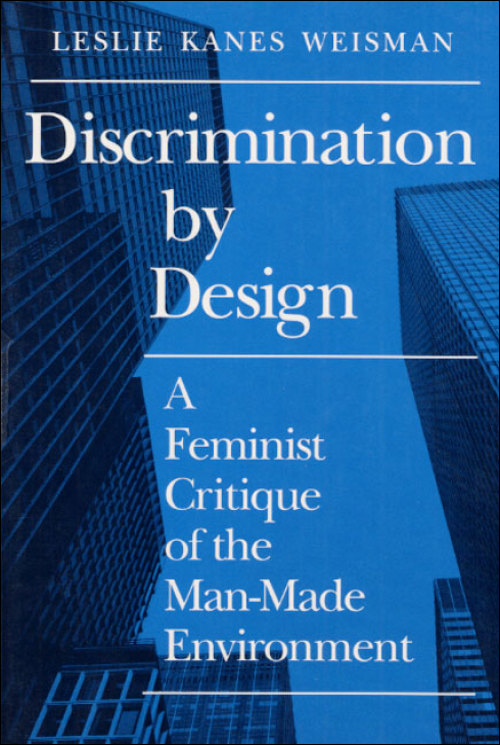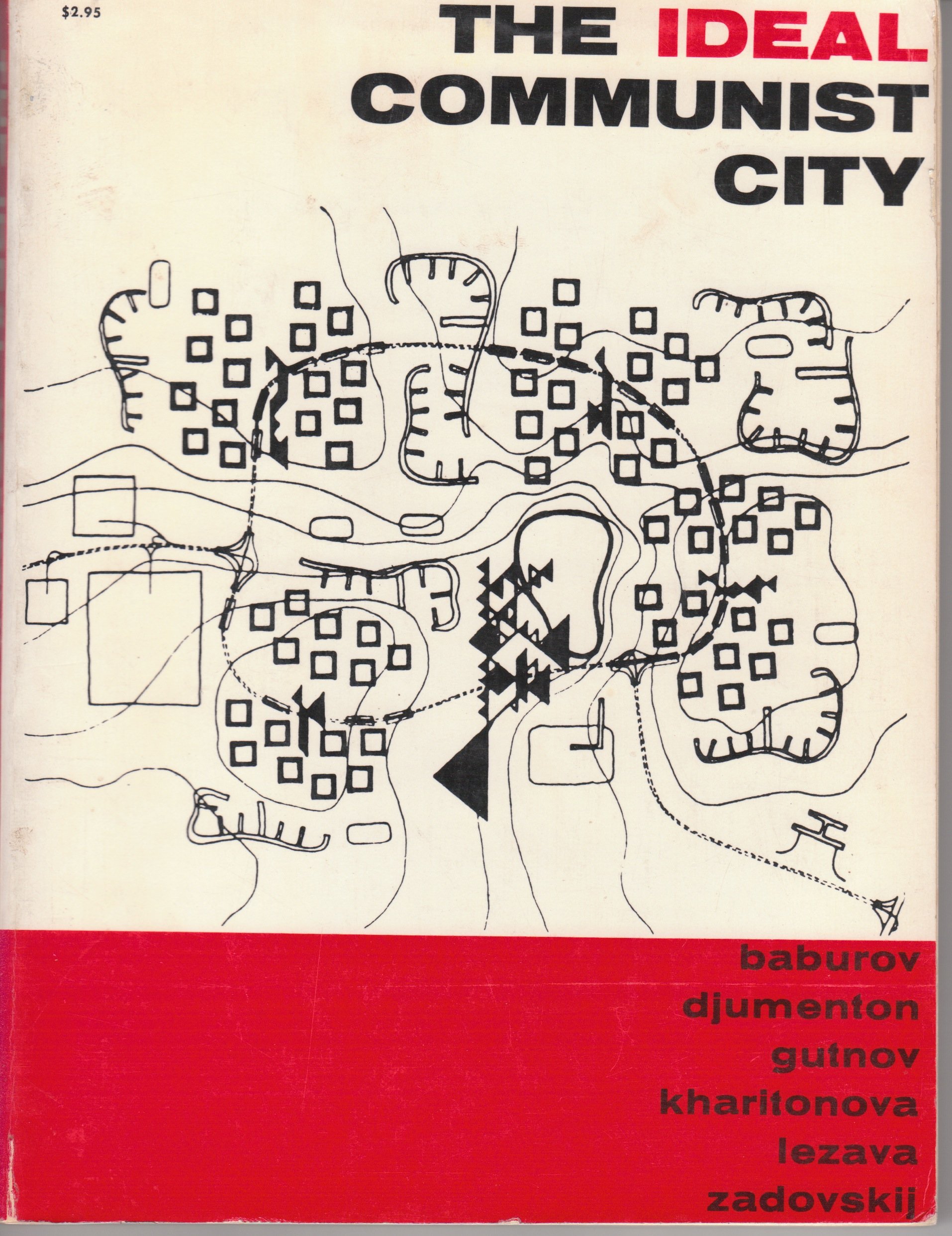Leslie Kanes Weisman: Discrimination by Design: A Feminist Critique of the Man-Made Environment (1992)
Filed under book | Tags: · architecture, city, feminism, home, public space, universal design, urban planning, women

“Discrimination by Design is a fascinating account of the complex social processes and power struggles involved in building and controlling space. Leslie Kanes Weisman offers a new framework for understanding the spatial dimensions of gender and race as well as class. She traces the social and architectural histories of the skyscraper, maternity hospital, department store, shopping mall, nuclear family dream house, and public housing high rise. Her vivid prose is based on exhaustive research and documents how each setting, along with public parks and streets, embodies and transmits the privileges and penalties of social caste.
In presenting feminist themes from a spatial perspective, Weisman raises many new and important questions. When do women feel unsafe in cities, and why? Why do so many homeless people prefer to sleep on the streets rather than in city-run shelters? Why does the current housing crisis pose a greater threat to women than to men? How would dwellings, communities, and public buildings look if they were designed to foster relationships of equality and environmental wholeness? And how can we begin to imagine such a radically different landscape?
In exploring the answers, the author introduces us to the people, policies, architectural innovations, and ideologies working today to shape a future in which all people matter. Richly illustrated with photographs and drawings, Discrimination by Design is an invaluable and pioneering contribution to our understanding of the issues of our time–health care for the elderly and people with AIDS, homelessness, racial justice, changing conditions of work and family life, affordable housing, militarism, energy conservation, and thepreservation of the environment. This thoroughly readable book provides practical guidance to policymakers, architects, planners, and housing activists. It should be read by all who are interested in understanding how the built environment shapes the experiences of their daily lives and the cultural assumptions in which they are immersed.” (from the back cover)
Publisher University of Illinois Press, Urbana, 1992
ISBN 0252063996, 9780252063992
x+190 pages
Reviews: Gail Lee Dubrow (Journal of Planning Education and Research, 1993), Esther da Costa Meyer (NWSA Journal, 1993), Diane Favro (Journal of American History, 1994), Joanne K. Guilfoil (Journal of Social Theory in Art Education, 1994), Irene Nierhaus (L’Homme, 1994, DE), Nancy M. Somerick (Public Relations Review, 1995).
Commentary: Spatial Agency (n.d.).
Alexei Gutnov, et al: The Ideal Communist City (1966–) [RU, EN]
Filed under book | Tags: · architecture, city, communism, constructivism, marxism, urban planning, urbanism

“The Soviet group of architects New Element of Settlement (NER) was invited to the 1968 Milan Triennale by Giancarlo De Carlo, following the publication of their influential book NER, On the Way to a New City (1966). They were asked to present their plans for an ideal communist city in the section devoted to “transformations of the physical environment.” Their installation was one of the few in the exhibition that provided a critical response to the culture of consumerism, in tune with ongoing student revolts.
The concept of NER was first developed in 1957 as a diploma project by graduates of the Moscow Institute of Architecture (MArkhI). As students, NER members studied the elements of the city, its quantitative and qualitative characteristics, eventually dismissing traditional planning principles in favor of a new approach to urban development as a dynamic process. Drawing on Marxism, they sought to provide a spatial agenda for the communist ideology, representing the younger generation of thinkers in the radical split of the Soviet architectural profession following de-Stalinization. They actively criticized the state of Soviet urban planning, arguing that “today, the city is not fulfilling its primary purpose to be an organic living environment.”
In late 1968, De Carlo wrote an introduction for NER’s influential publication, The Ideal Communist City. In their radical proposal, NER attempted to provide a spatial agenda for Marxism, drawing both from the Communist Manifesto and the Constructivist avant-garde of the 1920s. NER’s new city was based on creative communication in a classless society, in which the city was no longer dependent on its industrial center but instead formed around a center of communication, independent from the economic characteristics of the city. The major shift brought in by this new urban wave—later implemented by one of its members, Alexei Gutnov, within the curriculum of MArkhI—was to see the city as a living organism, in which cells would be born and eventually die. This led to a change in the status of architectural form: it was conceived as temporary and mobile—its birth implied the process of its imminent destruction. This approach anticipated the later understanding of architecture as an activity or as environment—form was no longer relevant because it hindered the organic processes within the dying city. The system emphasized the correspondence between urban structures and social relationships in communism, based on the reading of the urban plan as “simultaneously a symbol of the idea and a program for its realization.”” (Masha Panteleyeva, Radical Pedagogies)
English edition
By Alexei Gutnov, A. Baburov, G. Djumenton, S. Kharitonova, I. Lezava, S. Sadovskij, of Moscow University
Translated by Renee Neu Watkins
Preface by Giancarlo de Carlo
Publisher George Braziller, New York, [1971]
i Press Series on the Human Environment
ISBN 080760576X 9780807605769
166 pages
via Outlaw Urbanist
Reviews: Kenneth Frampton (Architectural Forum, 1972), Outlaw Urbanist (2016).
Commentary: Alicia Kurimska (Center for Opportunity Urbanism, 2015).
Novyy element rasseleniya: na puti k novomu gorodu (Новый элемент расселения: на пути к новому городу, Russian, 1966, 22 MB, via)
The Ideal Communist City (English, trans. Renee Neu Watkins, [1971], 4 MB)
Colin Rowe, Fred Koetter: Collage City (1978–) [EN, DE, ES]
Filed under book | Tags: · architecture, bricolage, city, collage, modernism, postmodernism, theory, urban design, urban planning, urbanism, utopia

“A theoretical treatise that sets out various analyses of urban form in a number of existing cities known to be aesthetically successful, examining their actually existing urban structure as found, revealing it to be the end product of a ceaseless process of fragmentation, the collision / superimposition / contamination of many diverse ideas imposed on it by successive generations, each with its own idea.”
A major thesis on urban interaction which first introduced the concept of “bricolage” to urban theory.
Publisher MIT Press, 1978
ISBN 0262180863, 9780262180863
186 pages
Commentary: ANY 7-8, dedicated to Rowe’s work (ed. Robert Somol, 1994), K. Michael Hays (Architecture Theory Since 1968, 1998), Joan Ockman (Journal of the Society of Architectural Historians, 1998), Anthony Vidler (Architectural Review, 2011).
Review: Ed Cutler (2010).
Collage City (English, 1978, 99 MB, via)
Collage City (German, trans. Bernhard Hoesli, 1984, 37 MB)
Ciudad collage (Spanish, trans. Esteve Riambau Sauri, 1998, 23 MB, via)
Introduction to French edition (1993)

